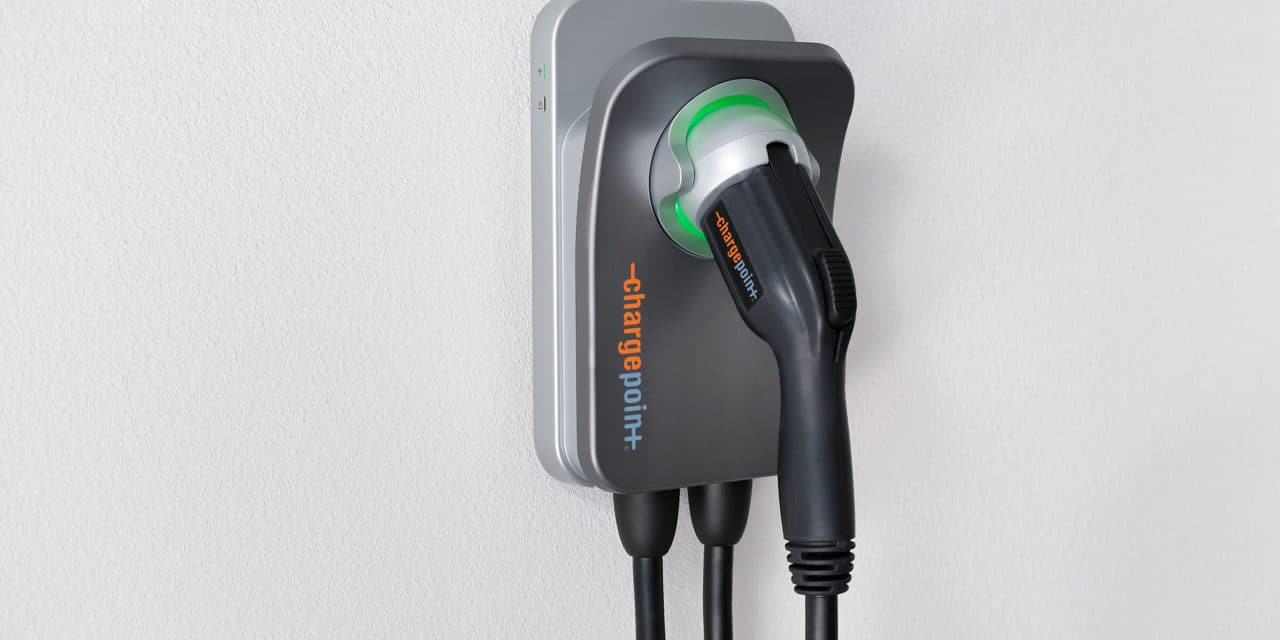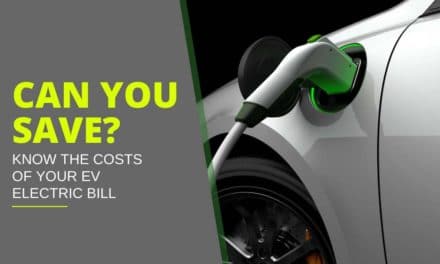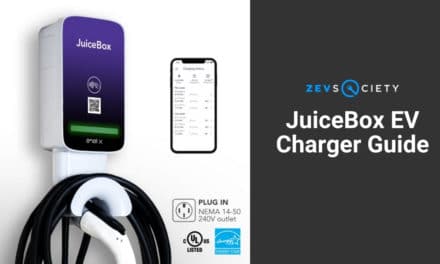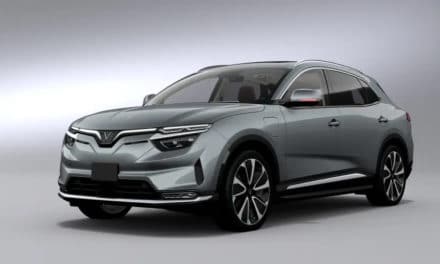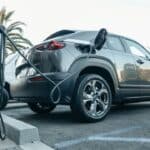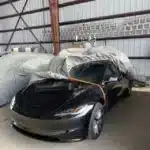Charging your electric vehicle at home makes owning an electric vehicle easier and convenient. Home electric vehicle (EV) charging is even better when you upgrade your wall outlet to a Level 2 240V home charger. This can add 12 to 60 miles of range per hour of charging. Faster charging will help you get the most out of your electric vehicle for local and long-distance trips. Let’s take a look at the EV charging technology available for your home!
About Home EV Charging Stations
A home charger or electric vehicle supply equipment (EVSE) supplies power to your electric vehicle, charging the battery with an onboard charger inside the car. To keep it simple, they are just called chargers.
Most home EV chargers use a universal connector. Tesla vehicles have an adaptor, and Tesla chargers are the exception as they will only work to charge Teslas. Home charge compatibility is not usually an issue, but there are some factors to consider.
Speed
Level 2 chargers use 240V power, but the charge speed differs based on the amp, electrical current, and charger’s output. How much speed you need will depend on the range of your electric vehicle, your commute distance, and your style of driving. Lower ranges, long commutes, or high-speed driving will mean you need a faster charge speed. Most EVs can tolerate about 32 amps, which adds about 25 miles of range per hour of charging, so this is a good choice for most electric vehicles. You may want to increase your speed using a 50 amp charger, which will add about 37 miles of range per hour.
Supply
As previously stated, Level 2 EV chargers require a 240V connection. It’s necessary to select a charger that is compatible with both your car and your home’s electrical capacity. Most electrical codes require your circuit to be rated for 25% more amperage than your charger’s output. Check your electrical panel to find out your available amperage before purchasing a charger.
Location
ENERGY STAR certifications on chargers will tell you that it is safe to use in your home. The certification means that it uses a minimal amount of energy when it’s not charging, which helps lower your electricity costs. If you charge almost daily, you might want to avoid portable chargers, as appealing as they may seem. Portable chargers require cables and connectors that drag on the ground and aren’t very safe. If you have children or pets, they become even more dangerous. Consider buying a wall-mounted charging station with a place to hang your cables when they’re not plugged in.
Cost Savings
Some electric companies are now offering lower rate plans if you charge your EV during off-peak hours, like overnight. Many chargers have built-in scheduling features, so you don’t have to plug them in to start charging manually.
Smart Chargers
Chargers can be WiFi-enabled to connect to an app for charge management. Scheduling and reminders are the primary functions of these smart chargers, but you can also track your charging costs and miles driven within the apps.
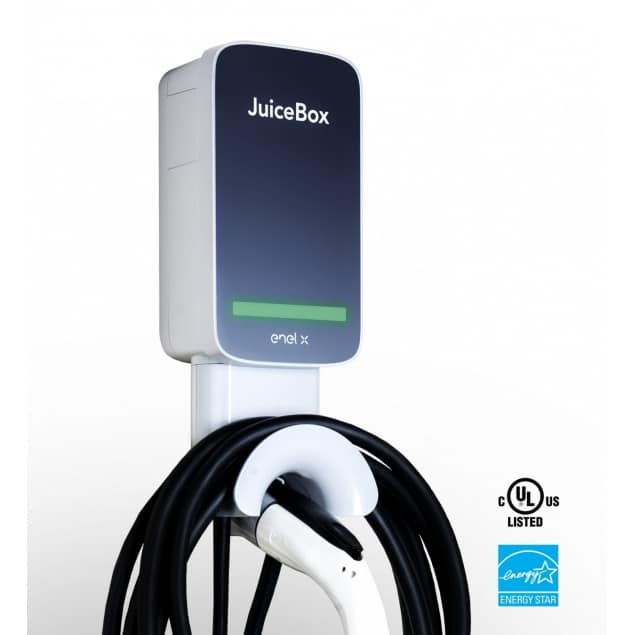
Top Brands of Home EV Chargers
JuiceBox Pro 40
JuiceBox has the highest available power, at 40 amps, for charging your existing car or giving you room to grow with a larger-battery electric vehicle. Everything can be controlled via JuiceBox’s app, including scheduling, monitoring for peak electricity demand, and getting notifications to plug your car in. If you have multiple electric vehicles, you can configure multiple JuiceBox charging stations that will self-monitor to ensure you don’t exceed your electrical supply circuit.
JuiceBox charging stations can be used indoors or outdoors. They are user-friendly, easy to set up, and have reliable WiFi connectivity. Users report that their customer service is also top-notch. These are some of the reasons the JuiceBox Pro 40 is one of the top EV chargers on the market.
ChargePoint Home WiFi Connected EV Stations
The ChargePoint EVSE is also WiFi-enabled and functions very similarly to the JuiceBox charger. The most significant difference between the two is that ChargePoint has a lower amperage of 32 amps. The ChargePoint charger is EnergyStar certified and has fast charge times. It’s Alexa and Echo compatible for reminders and is also compatible with Nest smart home networks.
ChargePoint HomeFlex
The ChargePoint HomeFlex EV charger is a charger that offers you flexible amp output based on your needs at a given point in time. It can be set to charge between 16 and 50 amps to add varying range amounts per Hour. It has all the same features as other ChargePoint charging systems, with a bit of added flexibility to help you minimize charging costs.
Cost of Home EV Charging
In the case of home EV chargers, the adage is true: you get what you pay for. Home EV chargers cost between $500 and $900, or about half of what most drivers spend on gas per year. You will likely use your home EV charger for many years, so it’s worth buying one with a warranty that has passed safety inspections. Cheaper chargers are not always tested for safety and lack the extra features that come with WiFi-connected chargers.
Note that the cost of a home EV charger does not include the cost of installation. If your electrical panel doesn’t support the charger you choose, costs can add up quickly to upgrade your panel. Flexible amperage chargers or lower amperage chargers can help you save fees for expensive upgrades. Some areas will also require that you obtain an electrical permit before installing a charging station, which can also add to costs.
The actual price you will pay for a home EV charger will depend on your home’s age, permit requirements, the type of charger you choose, whether the installation is indoors or outdoors, and where you install your charger. Make sure to do your research before purchasing a charger that may be incompatible with your home.
The Takeaway
Home EV charging stations can save you money and hassle for charging your electric vehicle. ChargePoint and JuiceBox top the list of charging stations at a reasonable price. Make sure you consider your home’s electrical circuit capabilities before purchasing and be aware of your local requirements for installation.

